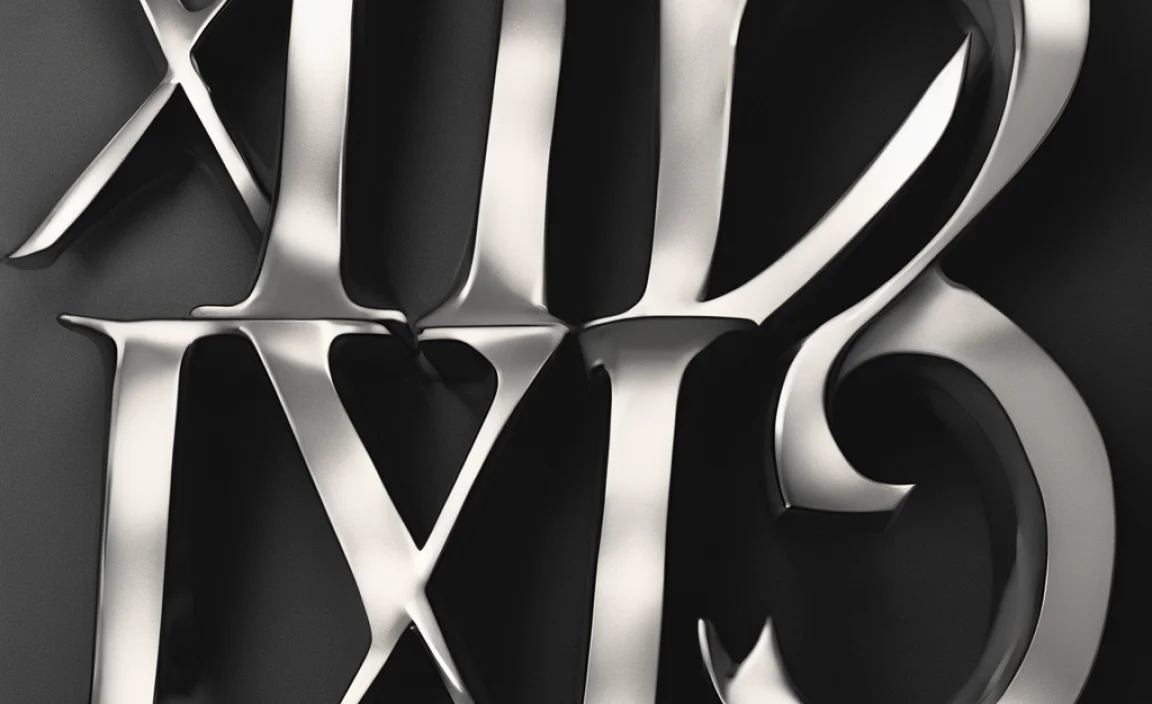The Riesling Font is a sophisticated, versatile typeface perfect for adding a touch of elegance and personality to your designs, from branding to web projects. Explore its unique characteristics and how to use it effectively.
Choosing the right font can feel like a puzzle. You want something that looks amazing, but also works well and is easy to read. It’s a common challenge for anyone diving into design, whether for a logo, a website, or even a social media post. Many beautiful fonts can be tricky to use, or just don’t fit certain projects. We’re here to make it simple. This guide will walk you through everything you need to know about the Riesling font, a truly special choice that can elevate your work. Get ready to discover a font that combines style with substance, and learn exactly how to make it shine.
What is the Riesling Font?
Riesling Font is a custom typeface designed to evoke a sense of classic charm and modern sophistication. It falls into the category of a serif font, meaning it features small decorative strokes, known as serifs, at the ends of its main strokes. These serifs often lend a feeling of tradition, readability, and elegance. What sets Riesling apart is its distinctive character – it’s not simply a typical serif. It has a unique flair that feels both artistic and approachable, making it a standout choice for projects seeking a memorable identity.
Created with attention to detail, Riesling offers a blend of personality and practicality. Its forms are clean enough for body text in certain applications, yet possess enough stylistic distinction to capture attention as a title or headline font. This versatility makes it a valuable asset in any designer’s toolkit. We’ll explore its origins, key features, and where it shines brightest.
Origins and Inspiration
While specific, publicly documented design origins for every custom font can be elusive, the aesthetic of fonts like Riesling often draws inspiration from several key areas. The name itself suggests a connection to the celebrated Riesling grape and the wines it produces – known for their balance, complexity, and often delicate yet distinctive aromas. This can translate into a font that feels refined, perhaps with a subtle sweetness or zest in its letterforms.
Typography masters often look to historical letterforms for inspiration. Riesling likely shares DNA with historical serif styles, perhaps drawing from old-style or transitional serifs that were popular in the 18th and 19th centuries. These fonts are characterized by a moderate contrast between thick and thin strokes and a graceful, organic flow. However, a modern interpretation means Riesling probably incorporates contemporary design sensibilities, ensuring it feels fresh and relevant for today’s digital and print landscapes. The goal is to capture a timeless quality with a unique, personal touch.
Key Features of the Riesling Font
Understanding the specific characteristics of Riesling is crucial for using it effectively. These features define its personality and guide its application.
- Elegant Serifs: The serifs are typically refined and well-defined, adding a touch of class without being overly ornate or distracting. They contribute to the font’s structured yet flowing appearance.
- Balanced Stroke Contrast: Riesling usually features a noticeable, but not extreme, contrast between thick and thin strokes. This variation adds visual interest and contributes to its sophisticated look, helping it stand out from monolinear sans-serifs.
- Distinctive Letterforms: Certain letters in the Riesling font might have unique treatments – perhaps a more curved tail on a ‘Q’, a slightly different ascender or descender shape, or a unique curve in its ‘S’. These distinct touches are what give the font its individual personality.
- Excellent Readability: Despite its stylistic elements, Riesling is generally designed with readability in mind, especially for key characters. This makes it suitable for headlines and, in some cases, short blocks of text where legibility is paramount.
- Versatile Weight Options: Many font families, including well-developed ones like Riesling, come in multiple weights (e.g., Light, Regular, Bold). This allows for hierarchical design, where different weights can be used for different purposes within the same project.
- Good Character Set Coverage: A well-designed font like Riesling will support a wide range of characters, including multiple languages, punctuation marks, and common symbols, making it functional for international projects.
Where to Use the Riesling Font
The unique blend of elegance and character makes Riesling a flexible choice for a variety of design projects. Its strength lies in applications where personality and a touch of refinement are desired.
Branding and Logos
Riesling is an excellent choice for brands that want to convey sophistication, heritage, or a handcrafted feel. It works wonderfully for:
- Boutique businesses (fashion, artisanal food, wellness)
- High-end services (consulting, financial advising)
- Alcoholic beverages (wineries, craft distilleries)
- Luxury goods
Its distinctive letterforms can create a memorable and unique logo that speaks volumes about the brand’s identity.
Web Design
When used strategically, Riesling can enhance a website’s appeal. It’s particularly effective for:
- Headlines and Titles: Its strong character makes it perfect for grabbing attention.
- Feature Sections: Use it for key call-to-action buttons or prominent site headings.
- Parallax Scrolling Elements: A striking font like Riesling can add depth and visual interest as users scroll.
- Elementor or WordPress Websites: Many modern website builders allow you to easily integrate custom fonts like Riesling, making it accessible even for non-developers.
While its readability for long paragraphs might depend on the specific weight and line spacing, it can certainly be used for shorter web copy or as a complementary display font.
Print Design
In print, Riesling truly shines, adding a tactile and classic feel to:
- Invitations and Stationery: Perfect for weddings, elegant parties, or formal announcements.
- Book Covers and Editorial Design: It can lend gravitas and artistic flair to literary works or magazine layouts.
- Brochures and Marketing Materials: Especially for premium products or services.
- Packaging: For products aiming for a sophisticated or artisanal market.
Personal Projects
From personal blogs to handcrafted item tags, Riesling can elevate any creative endeavor. If you’re looking to add a touch of class and unique personality, this font is a fantastic option.
Pairing Riesling Font with Other Fonts
The art of font pairing is about creating harmony and distinction. Riesling, with its distinct personality, can be paired effectively with fonts that complement rather than compete with it. The key is to identify what makes Riesling work and then find other fonts that balance its characteristics.
Complementary Serif Fonts
If you want to stick within the serif realm but offer a contrast, choose a serif font that is:
- More humanist or traditional: For example, a Garamond or a Palatino-style font can provide a familiar, grounded counterpoint.
- Less decorative: A simpler, cleaner serif can allow Riesling to be the star, while still maintaining a classic feel.
Contrasting Sans-Serif Fonts
Sans-serif fonts are often the best partners for serifs, creating a clear visual hierarchy and modern appeal. Riesling pairs well with:
- Clean, geometric sans-serifs: Think fonts like Lato, Open Sans, or Montserrat. Their straightforward forms provide a clean backdrop for Riesling’s flair.
- Humanist sans-serifs: Fonts like Roboto or Source Sans Pro offer a bit more character while remaining highly readable and friendly.
- Lightweight or bold sans-serifs: Depending on the weight of Riesling you’re using, choosing a contrasting sans-serif weight can create effective contrast and hierarchy.
Script or Display Fonts (Use Sparingly)
If you are already using Riesling as a display font, introducing another highly decorative script or display font can lead to chaos. However, if Riesling is used for body text or a secondary heading, a very subtle, elegant script could be used for a very small accent. Generally, it’s best to limit yourself to one or two highly distinctive fonts.
Font Pairing Table Example
Here’s a quick look at some potential pairings:
| Riesling Font Use | Pairing Font Type | Example Fonts | Purpose |
|---|---|---|---|
| Headlines/Titles | Clean Sans-Serif | Open Sans, Lato, Montserrat | Provides readability and modern contrast. |
| Body Text (short sections) | Humanist Serif | Garamond, Palatino | Maintains a classic, literary feel. |
| Subheadings | Slightly bolder Sans-Serif | Roboto Medium, Source Sans Pro Semibold | Creates clear hierarchy without competing. |
| Accents (limited) | Elegant Script (very subtle) | A simple, delicate script | Adds a touch of flourish, use very sparingly. |
How to Optimize Riesling Font for Web Use
For web designers, incorporating any font requires a strategic approach to ensure optimal performance and user experience. Here’s how to make the Riesling font work beautifully online:
1. Licensing and Performance
Before you start, ensure you have the correct license for web use. Many font foundries offer specific web licenses. Once acquired, you’ll need to implement the font correctly. This often involves using CSS (`@font-face` rule) or leveraging font services like Google Fonts (if Riesling is available there) or Adobe Fonts.
Performance Tip: Only load the font weights you intend to use. Loading too many weights can slow down your website significantly. For example, if you only plan to use Riesling Regular and Bold for headlines, don’t load the Italic or Light versions unless necessary.
2. File Formats
For web fonts, you’ll typically encounter several file formats:
- WOFF (Web Open Font Format): The most widely supported and recommended format.
- WOFF2: A newer, more compressed version offering even better performance.
- TTF/OTF (TrueType Font/OpenType Font): Older formats that may be needed for some legacy browsers.
When using `@font-face` in CSS, you can specify multiple formats to ensure broad compatibility. A common practice is to list WOFF2 first, followed by WOFF.
Example CSS snippet using @font-face:
@font-face {
font-family: 'Riesling';
src: url('riesling-regular.woff2') format('woff2'),
url('riesling-regular.woff') format('woff');
font-weight: normal;
font-style: normal;
}
@font-face {
font-family: 'Riesling';
src: url('riesling-bold.woff2') format('woff2'),
url('riesling-bold.woff') format('woff');
font-weight: bold;
font-style: normal;
}
3. Readability and Size
Riesling is often a display font, meaning it’s best suited for larger text sizes. For body text, consider:
- Using a lighter weight of Riesling: If available, a Regular or Light weight might be more readable for longer passages.
- Pairing with a highly readable sans-serif: As mentioned, a clean sans-serif for body copy will provide excellent contrast and legibility, while Riesling remains for headlines.
- Adjusting line height (`line-height`): Adequate spacing between lines is critical for readability. Aim for a line height of 1.4 to 1.6 for body text.
- Font sizing: Ensure headings using Riesling are large enough to be impactful but not so large they overwhelm the layout or become difficult to read. For body text, stick to accessible sizes (e.g., 16px is a good baseline for browser default).
4. Testing Across Devices
Always test your website on various devices and screen resolutions. What looks great on a desktop might render differently on a mobile phone. Ensure Riesling remains clear and attractive across the board. Consider using responsive font sizing techniques or media queries in your CSS.
5. Accessibility Considerations
Ensure sufficient color contrast between your text and background. Tools from institutions like the Web Content Accessibility Guidelines (WCAG) can help you check this. For users with visual impairments, highly decorative fonts can sometimes be challenging, so balance aesthetic choice with accessibility needs, especially for essential information.
Pros and Cons of Using Riesling Font
Every font has its strengths and weaknesses, and Riesling is no exception. Understanding these can help you decide if it’s the right choice for your specific project.
Pros:
- Unique Personality: Offers a distinctive look that stands out from more common fonts.
- Elegant and Sophisticated: Perfect for brands or projects aiming for a premium, classic, or artistic feel.
- Versatile in Application: Suitable for a range of uses from logos and headlines to invitations.
- Improved Readability for Display: Specific letterforms are usually designed for clarity when used at larger sizes.
- Adds Emotional Depth: Can evoke feelings of warmth, craftsmanship, and attention to detail.
Cons:
- Potential Readability Issues for Long Text: Like many display fonts, extensive blocks of Riesling might be tiring to read for long passages, depending on its design and weight.
- Licensing Costs: Custom or premium fonts often require a purchase for commercial use, which can be a factor for budget-conscious projects.
- Overuse Risk: Because it’s distinctive, overusing it or pairing it poorly can make a design look cluttered or unprofessional.
- Browser/Software Support: While generally good, ensure it’s properly implemented for all intended platforms.
- Can Feel Too Specific: For very modern, minimalist, or tech-focused brands, Riesling might feel out of place.
Getting Started with Riesling Font
Ready to add Riesling to your design arsenal? Here’s a straightforward path to get you started:
1. Find and License the Font
Search for “Riesling font” online. Reputable font foundries and marketplaces are the best places to look. Websites like MyFonts, Fontspring, or directly from independent type designers are good starting points.
When you find it, carefully review the licensing options. Ensure you select a license that covers your intended use (e.g., desktop, web, app). If your budget is tight, explore free font alternatives that capture a similar aesthetic, though often with fewer features or a less refined character.
Tiers of Font Licensing:
Font licenses come in various forms:
-
Desktop License: For installation on your computer for use in design software like Adobe Photoshop, Illustrator, InDesign, or even Microsoft Word. This is essential for print design and creating graphic assets.
-
Web License: For embedding the font on websites. This is usually priced based on monthly pageviews or traffic. For example, Google Fonts offers free, open-source licensing for many fonts, making web use straightforward.
-
App & Software License: For embedding within mobile applications or software.
-
Commercial License: Covers use in marketing materials, logos, products for sale, etc. This is often a requirement beyond basic desktop use for branding.
2. Install the Font
Once purchased and downloaded, you’ll typically get font files (e.g., `.otf`, `.ttf`). Double-







